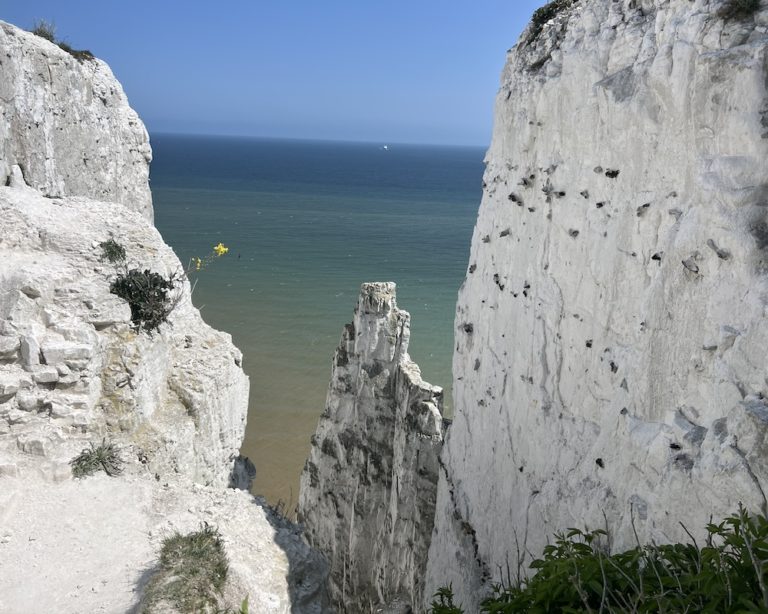White Cliffs of Dover, UK
A Natural Wonder of Coastal Beauty





It’s impressive how nature can captivate our senses and leave us speechless. The White Cliffs of Dover are one such breathtaking sight, located on the southeast coast of England. For centuries, poets, artists, and travelers have admired these chalk cliffs, which offer a glimpse into the world’s geological wonders. Let’s check out the history, significance, and beauty of the White Cliffs of Dover here.
History behind The White Cliffs: A Natural Marvel
Geological Fact:
Dover’s White Cliffs emerged after a remarkable process millions of years ago. During the Late Cretaceous period, when the area was submerged under a shallow sea, layers of calcium carbonate built up over time from tiny marine organisms like coccoliths, which eventually turned into chalk. Their bright white color creates a striking contrast against the deep blue waters below. The geological process that created these cliffs shows how fascinating and intricate our planet is.
Historical Fact:
Historically, the White Cliffs of Dover served as a natural boundary, guarding the southeast shores of England against invasions and maritime threats. The cliffs served as a sign of hope for a better future for returning soldiers during World War II. Vera Lynn’s iconic song “The White Cliffs of Dover” solidified their place in collective memory. Standing tall and proud, these cliffs are a reminder of England’s deep sea connections and rich history.
Best White Cliffs of Dover Walks and Trails
The Dover coastal path offers some of the most spectacular walking routes in Britain. The most popular trail starts at the National Trust Visitor Centre and follows the clifftop path towards South Foreland Lighthouse. This well-maintained route provides stunning views of the English Channel and, on clear days, the French coastline.
For those seeking a more challenging adventure, the white cliffs hiking trails extend beyond the lighthouse towards St. Margaret’s Bay. This section of the path offers dramatic viewpoints and fewer crowds, making it perfect for photography enthusiasts and nature lovers.
Hidden Gems Along the Dover Cliffs
While most visitors stick to the main viewing areas, several lesser-known paths lead to secluded beaches and hidden coves. Fan Bay Deep Shelter, a network of World War II tunnels, lies beneath the white cliffs viewpoints and offers fascinating insights into the area’s military history. Book a guided tour in advance to explore this underground marvel.
Cliffs Through the Lens of The Traveller
From London, I took the train to Dover Priory. The cliff is easy to reach from Dover Priory station; Exit from Dover Priory station and walk along Folkestone Road and then through the town center. The streets are alive with the chatter of locals and the occasional laughter of visitors exploring this coastal gem. Leaving the town center behind, you’ll approach a quieter area. The road gently slopes uphill as you venture closer to the destination. On the left, you will start seeing glimpses of the English Channel, raising the excitement of the breathtaking view that awaits in this journey.
On your way, you will experience 360-degree glimpses of this natural landmark, embarking English Channel, Castle, and the path to White Cliff. As you continue to walk along the trail, you will embark on the Tower Tree Walk, an iconic natural wonder. The way trees are naturally bent, providing shade to the travelers, I felt like it was a set-up for a romantic movie. Loved walking through the Tower tree.
Throughout the walk, strategically placed benches and resting areas provide opportunities to pause, take in the awe-inspiring views, and appreciate the tranquility of the surroundings. The resting points also offer a chance to observe the diverse flora and fauna that inhabit the cliffs, including various bird species that nest in the area. There’s a network of walking trails maintained by the National Trust, so you can explore the cliffs at your own pace.
Dover’s White Cliffs are home to all kinds of animals and plants. The chalk grasslands that line the cliffs provide a habitat for rare and endangered plants, like the Adonis blue butterfly and the oxtongue broomrape. Cliffs are nesting sites for seabirds like fulmars, kittiwakes, and peregrine falcons, creating a thriving ecosystem. The National Trust and other organizations work hard to keep fragile ecosystems alive, ensuring plant and animal species continue to live here.
As you venture closer, you can witness the intricate layers and formations of the cliffs, shaped over millions of years by natural processes. You look out over the endless expanse of the English Channel as the squeaky-clean white rock sparkles in the sunlight. It’s a magical moment, evoking a sense of peace and quiet.
Travel Tips Over the Cliffs
-
- Whenever you walk towards the edge of the cliffs, be careful, there are cracked rocks. If you don’t look down, you might get hurt. I almost stepped on a fissured rock covered in green grass.
-
- At Lighthouse, you can get something to eat or use the toilets. There are no other eateries, stalls, or toilets available on your way from Cliff’s starting point to Lighthouse. You’ll have to carry your own food and drink to enjoy your hike; From the top, you’ll see the English Channel and even the French coast on a clear day.
-
- You can walk along these cliffs for miles, reaching heights of over 350 feet in some places. You can walk from one cliff point to another but do not walk too far beyond your stamina, or you’ll get hurt. All the cliff points offer beautiful views of the countryside.
In today’s world, the White Cliffs of Dover inspire people and attract tourists. As you explore the coast, you will see spectacular views of the Channel, with ferries and ships passing by gracefully. Also, the cliffs are home to diverse wildlife, including seabirds nesting on their ledges and seals basking in the water. It’s a beautiful example of a harmonious mix of nature and human endeavor showcasing their beauty.
I left with a profound sense of appreciation for the wonders that lie within our reach.
